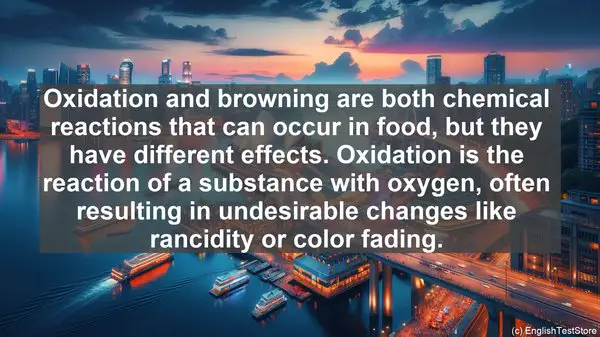Introduction: The Language of Food Chemistry
Welcome to our lesson on the top 10 commonly confused words in food chemistry. As a culinary student or someone interested in the science behind cooking, understanding these terms is essential. So let’s dive in!
1. Emulsion vs. Suspension
Emulsion and suspension are often used interchangeably, but they have distinct differences. An emulsion is a mixture of two immiscible liquids, like oil and water, where one is dispersed in the other. On the other hand, a suspension is a mixture of solid particles in a liquid, like flour in water. Understanding this difference is crucial for various culinary techniques, from making mayonnaise to creating stable dressings.
2. Infusion vs. Decoction
Infusion and decoction are both methods of extracting flavors from ingredients, but they differ in the process. Infusion involves steeping the ingredient, like tea leaves, in a liquid, usually hot water, to extract its flavors. Decoction, on the other hand, involves boiling the ingredient in water to extract its properties. Each method is suitable for different ingredients, and knowing when to use which is vital for achieving the desired taste in dishes.
3. Reduction vs. Evaporation
Reduction and evaporation are often used interchangeably, but they have distinct purposes. Reduction involves simmering a liquid, like a sauce or stock, to concentrate its flavors by evaporating the water content. On the other hand, evaporation is the process of turning a liquid into vapor, usually by heating. While both processes involve the removal of liquid, reduction is more focused on intensifying flavors, making it a crucial technique in culinary arts.
4. Fermentation vs. Spoilage
Fermentation and spoilage may both involve the transformation of food, but they have different outcomes. Fermentation is a controlled process where microorganisms, like yeast or bacteria, convert sugars into alcohol, acids, or gases. This process is used in various culinary staples like bread, cheese, and wine. Spoilage, on the other hand, is the result of uncontrolled microbial growth, leading to the deterioration of food, making it unsafe for consumption. Understanding the difference is crucial for food safety and the production of fermented delicacies.

5. Gelatinization vs. Starch Retrogradation
Gelatinization and starch retrogradation are both processes that involve the behavior of starch molecules, but they have different outcomes. Gelatinization occurs when starch is heated in the presence of liquid, causing it to absorb the liquid and swell, resulting in a thickened mixture. This process is essential in creating sauces, gravies, and other thickened preparations. Starch retrogradation, on the other hand, is the process where a gelatinized starch mixture, upon cooling, undergoes a structural change, leading to the formation of a firm gel. Understanding these processes is vital for achieving the desired texture in various dishes.
6. Oxidation vs. Browning
Oxidation and browning are both chemical reactions that can occur in food, but they have different effects. Oxidation is the reaction of a substance with oxygen, often resulting in undesirable changes like rancidity or color fading. Browning, on the other hand, is a desirable reaction that occurs when certain foods, like fruits or meats, are exposed to heat, resulting in a visually appealing golden-brown color and enhanced flavor. While oxidation is often unwanted, browning is a technique used in various cooking methods, from searing to baking.
7. Caramelization vs. Maillard Reaction
Caramelization and the Maillard reaction are both browning reactions, but they differ in the process and ingredients involved. Caramelization occurs when sugar is heated, leading to its breakdown and the formation of a golden-brown color and distinct flavor. The Maillard reaction, on the other hand, is a complex reaction between amino acids and reducing sugars, resulting in the browning of foods like bread, roasted meat, or coffee. Understanding these reactions is crucial for achieving the desired flavors and colors in various culinary preparations.
8. Homogenization vs. Homogenization
Homogenization and homogenization may sound similar, but they have different meanings. Homogenization is the process of reducing the size of fat globules in milk, ensuring a uniform distribution and preventing cream separation. On the other hand, homogenization refers to the process of making a mixture uniform by breaking down larger particles into smaller ones. While both processes involve achieving uniformity, they are used in different contexts in food chemistry.
9. Coagulation vs. Curdling
Coagulation and curdling are both processes that involve the solidification of proteins, but they have different connotations. Coagulation is the desirable process that occurs when proteins denature and form a network, resulting in the thickening or setting of a mixture, like in custards or cheese. Curdling, on the other hand, is the undesirable process where proteins denature and clump together, resulting in the separation of liquids, like in curdled milk. Understanding these processes is vital for achieving the desired texture in various culinary preparations.

10. Emulsifier vs. Stabilizer
Emulsifiers and stabilizers are both additives used in food, but they have different functions. An emulsifier is a substance that helps in the formation and stabilization of emulsions, ensuring that the immiscible liquids remain dispersed. Common emulsifiers include lecithin or egg yolks. Stabilizers, on the other hand, are substances that help in maintaining the texture and consistency of a food product, preventing separation or crystallization. Understanding the role of these additives is crucial for achieving the desired quality in various food preparations.
